Analysis of Business Structures, Funding Options, and Economic Sectors
VerifiedAdded on 2022/11/28
|13
|4142
|250
Report
AI Summary
This report provides a detailed analysis of business structures, funding options, and economic sectors within the United Kingdom. It begins by comparing different legal statuses of businesses, including private and public limited companies, outlining their strengths and weaknesses. The report then evaluates three business funding options: startup loans, small business grants, and private equity investments, assessing their respective advantages and disadvantages. Furthermore, it explores the three primary sectors of the UK economy – private, public, and third sectors – highlighting their characteristics and differences. Finally, the report discusses the importance of human resource policies in the modern workplace, emphasizing their role in fostering a productive and efficient work environment. The report provides valuable insights into the operational and financial aspects of businesses in the UK.
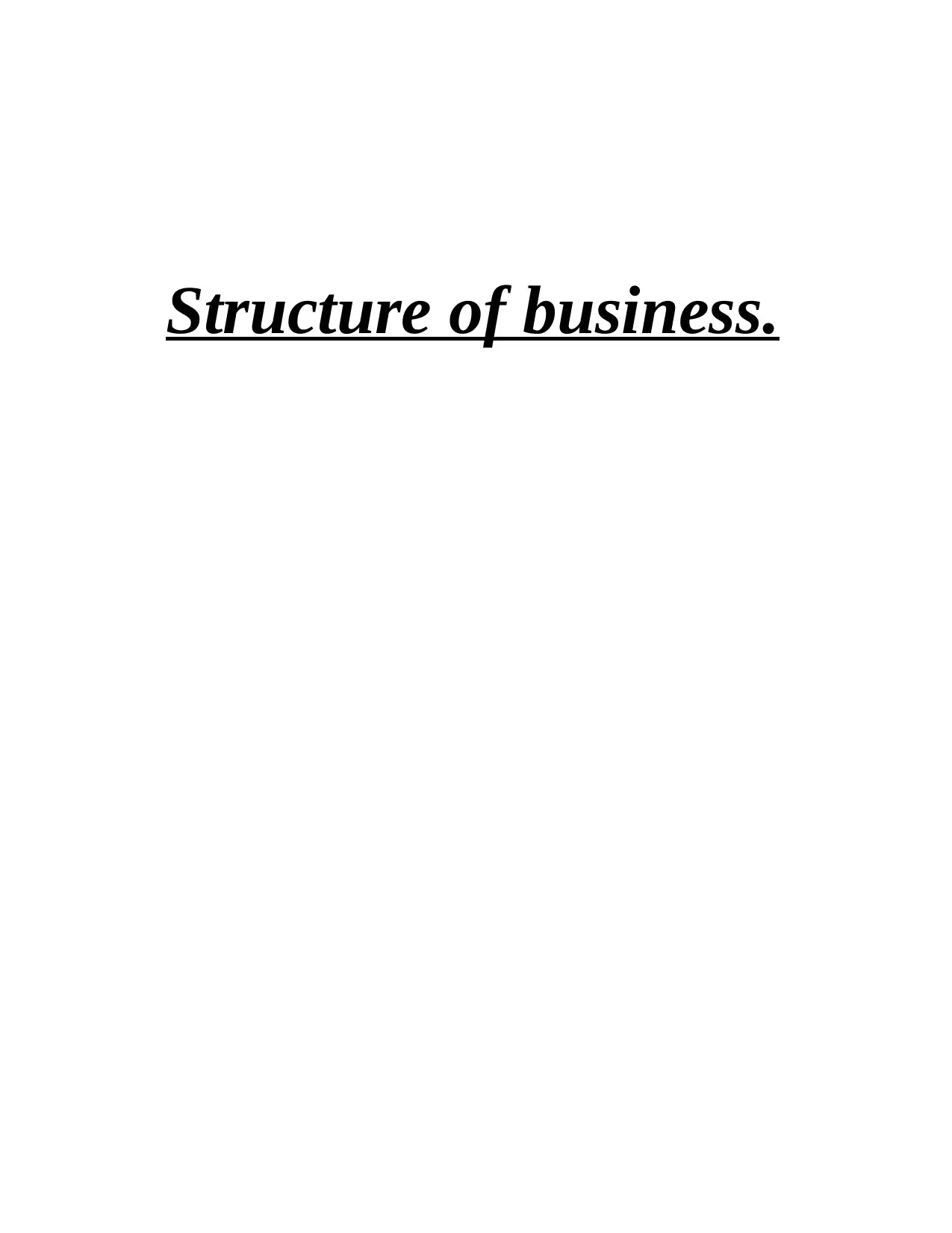
Structure of business.
Paraphrase This Document
Need a fresh take? Get an instant paraphrase of this document with our AI Paraphraser
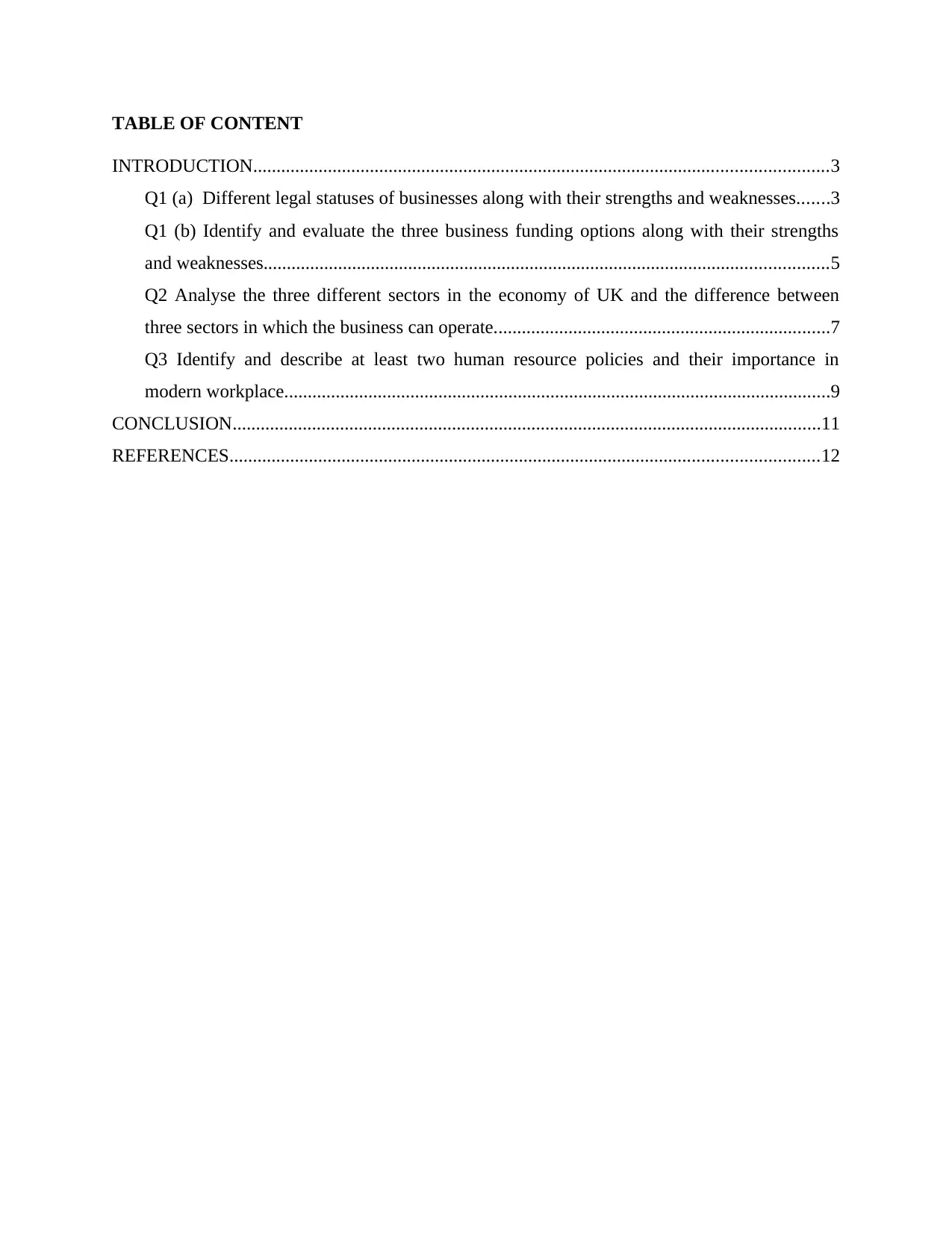
TABLE OF CONTENT
INTRODUCTION...........................................................................................................................3
Q1 (a) Different legal statuses of businesses along with their strengths and weaknesses.......3
Q1 (b) Identify and evaluate the three business funding options along with their strengths
and weaknesses.........................................................................................................................5
Q2 Analyse the three different sectors in the economy of UK and the difference between
three sectors in which the business can operate........................................................................7
Q3 Identify and describe at least two human resource policies and their importance in
modern workplace.....................................................................................................................9
CONCLUSION..............................................................................................................................11
REFERENCES..............................................................................................................................12
INTRODUCTION...........................................................................................................................3
Q1 (a) Different legal statuses of businesses along with their strengths and weaknesses.......3
Q1 (b) Identify and evaluate the three business funding options along with their strengths
and weaknesses.........................................................................................................................5
Q2 Analyse the three different sectors in the economy of UK and the difference between
three sectors in which the business can operate........................................................................7
Q3 Identify and describe at least two human resource policies and their importance in
modern workplace.....................................................................................................................9
CONCLUSION..............................................................................................................................11
REFERENCES..............................................................................................................................12
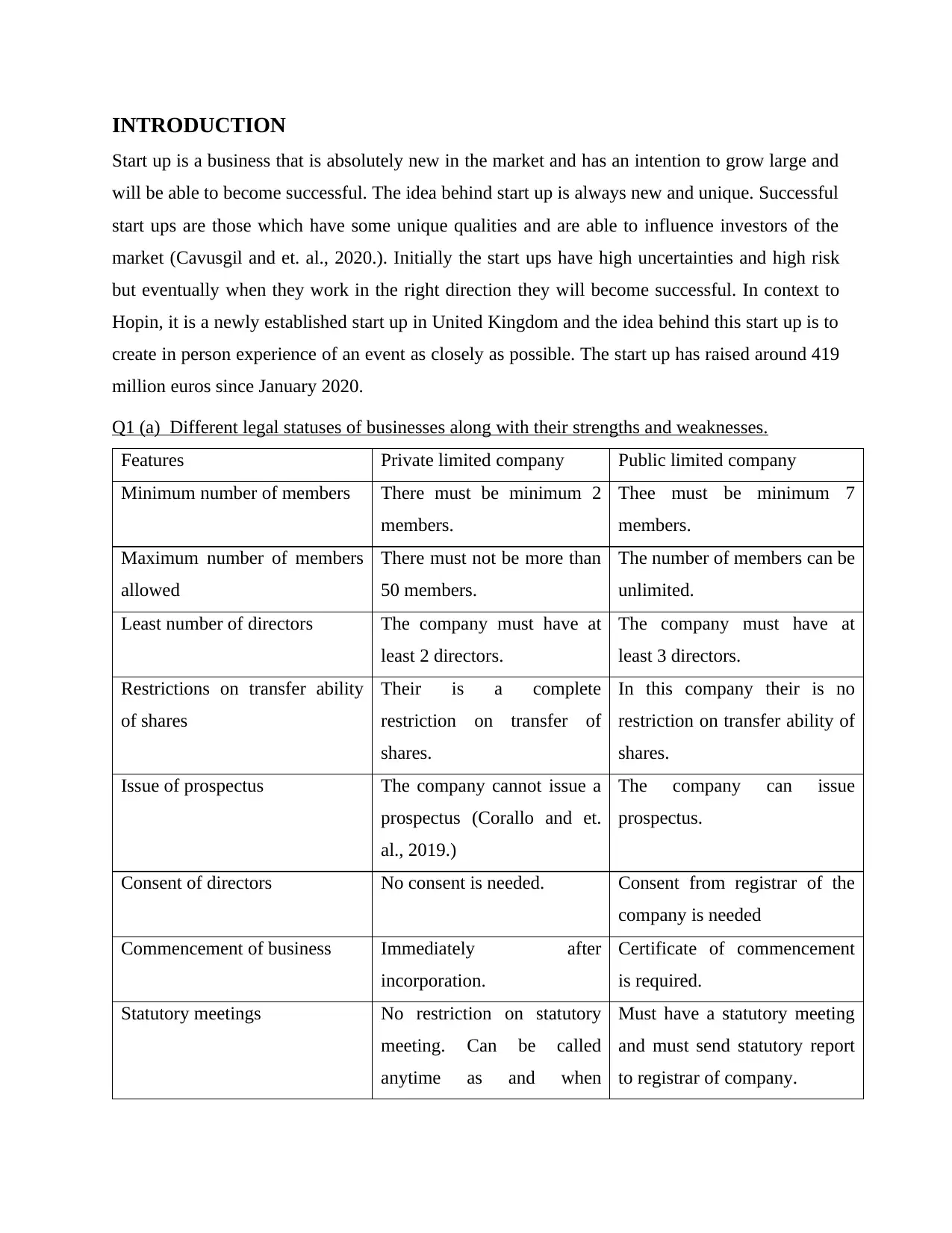
INTRODUCTION
Start up is a business that is absolutely new in the market and has an intention to grow large and
will be able to become successful. The idea behind start up is always new and unique. Successful
start ups are those which have some unique qualities and are able to influence investors of the
market (Cavusgil and et. al., 2020.). Initially the start ups have high uncertainties and high risk
but eventually when they work in the right direction they will become successful. In context to
Hopin, it is a newly established start up in United Kingdom and the idea behind this start up is to
create in person experience of an event as closely as possible. The start up has raised around 419
million euros since January 2020.
Q1 (a) Different legal statuses of businesses along with their strengths and weaknesses.
Features Private limited company Public limited company
Minimum number of members There must be minimum 2
members.
Thee must be minimum 7
members.
Maximum number of members
allowed
There must not be more than
50 members.
The number of members can be
unlimited.
Least number of directors The company must have at
least 2 directors.
The company must have at
least 3 directors.
Restrictions on transfer ability
of shares
Their is a complete
restriction on transfer of
shares.
In this company their is no
restriction on transfer ability of
shares.
Issue of prospectus The company cannot issue a
prospectus (Corallo and et.
al., 2019.)
The company can issue
prospectus.
Consent of directors No consent is needed. Consent from registrar of the
company is needed
Commencement of business Immediately after
incorporation.
Certificate of commencement
is required.
Statutory meetings No restriction on statutory
meeting. Can be called
anytime as and when
Must have a statutory meeting
and must send statutory report
to registrar of company.
Start up is a business that is absolutely new in the market and has an intention to grow large and
will be able to become successful. The idea behind start up is always new and unique. Successful
start ups are those which have some unique qualities and are able to influence investors of the
market (Cavusgil and et. al., 2020.). Initially the start ups have high uncertainties and high risk
but eventually when they work in the right direction they will become successful. In context to
Hopin, it is a newly established start up in United Kingdom and the idea behind this start up is to
create in person experience of an event as closely as possible. The start up has raised around 419
million euros since January 2020.
Q1 (a) Different legal statuses of businesses along with their strengths and weaknesses.
Features Private limited company Public limited company
Minimum number of members There must be minimum 2
members.
Thee must be minimum 7
members.
Maximum number of members
allowed
There must not be more than
50 members.
The number of members can be
unlimited.
Least number of directors The company must have at
least 2 directors.
The company must have at
least 3 directors.
Restrictions on transfer ability
of shares
Their is a complete
restriction on transfer of
shares.
In this company their is no
restriction on transfer ability of
shares.
Issue of prospectus The company cannot issue a
prospectus (Corallo and et.
al., 2019.)
The company can issue
prospectus.
Consent of directors No consent is needed. Consent from registrar of the
company is needed
Commencement of business Immediately after
incorporation.
Certificate of commencement
is required.
Statutory meetings No restriction on statutory
meeting. Can be called
anytime as and when
Must have a statutory meeting
and must send statutory report
to registrar of company.
⊘ This is a preview!⊘
Do you want full access?
Subscribe today to unlock all pages.

Trusted by 1+ million students worldwide
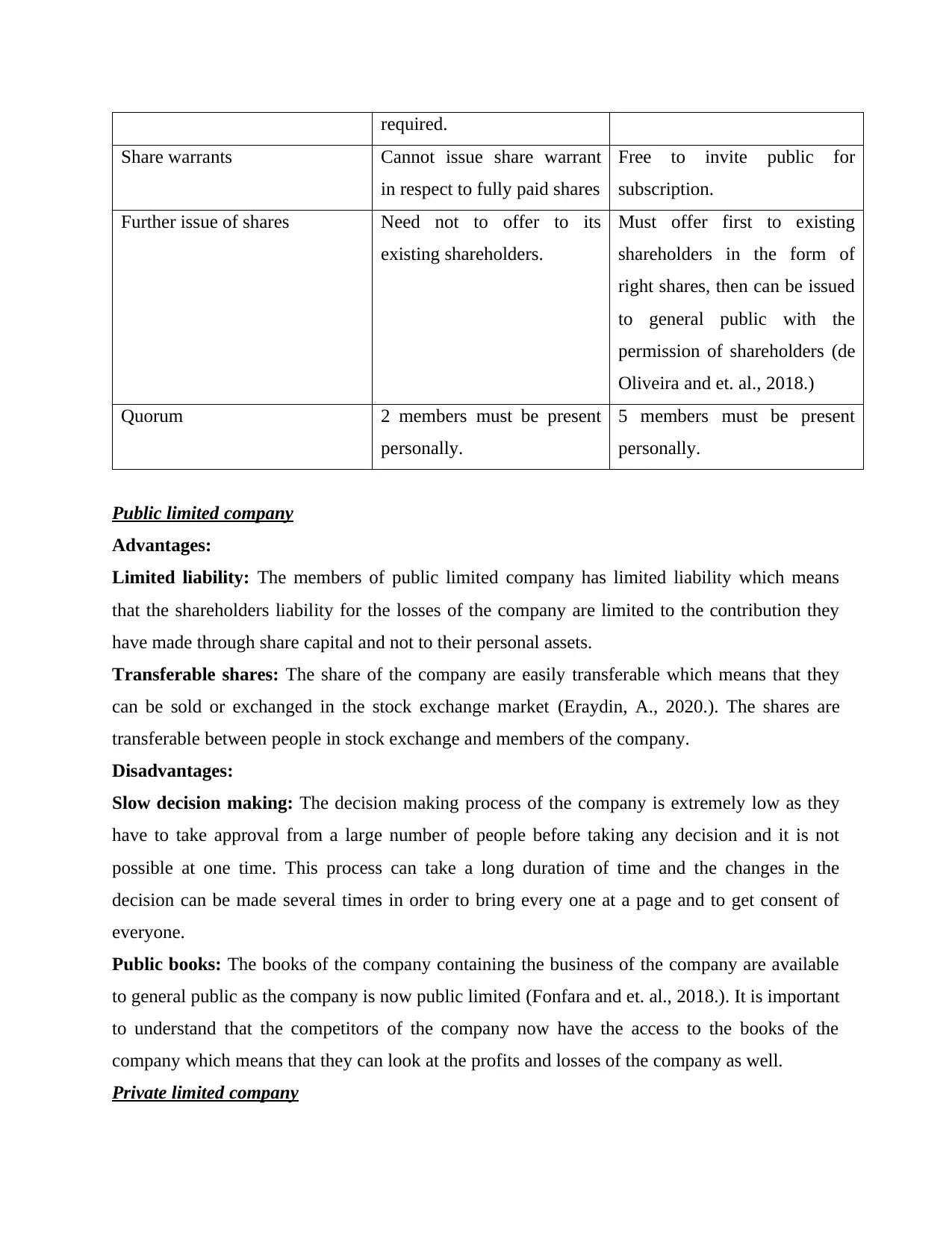
required.
Share warrants Cannot issue share warrant
in respect to fully paid shares
Free to invite public for
subscription.
Further issue of shares Need not to offer to its
existing shareholders.
Must offer first to existing
shareholders in the form of
right shares, then can be issued
to general public with the
permission of shareholders (de
Oliveira and et. al., 2018.)
Quorum 2 members must be present
personally.
5 members must be present
personally.
Public limited company
Advantages:
Limited liability: The members of public limited company has limited liability which means
that the shareholders liability for the losses of the company are limited to the contribution they
have made through share capital and not to their personal assets.
Transferable shares: The share of the company are easily transferable which means that they
can be sold or exchanged in the stock exchange market (Eraydin, A., 2020.). The shares are
transferable between people in stock exchange and members of the company.
Disadvantages:
Slow decision making: The decision making process of the company is extremely low as they
have to take approval from a large number of people before taking any decision and it is not
possible at one time. This process can take a long duration of time and the changes in the
decision can be made several times in order to bring every one at a page and to get consent of
everyone.
Public books: The books of the company containing the business of the company are available
to general public as the company is now public limited (Fonfara and et. al., 2018.). It is important
to understand that the competitors of the company now have the access to the books of the
company which means that they can look at the profits and losses of the company as well.
Private limited company
Share warrants Cannot issue share warrant
in respect to fully paid shares
Free to invite public for
subscription.
Further issue of shares Need not to offer to its
existing shareholders.
Must offer first to existing
shareholders in the form of
right shares, then can be issued
to general public with the
permission of shareholders (de
Oliveira and et. al., 2018.)
Quorum 2 members must be present
personally.
5 members must be present
personally.
Public limited company
Advantages:
Limited liability: The members of public limited company has limited liability which means
that the shareholders liability for the losses of the company are limited to the contribution they
have made through share capital and not to their personal assets.
Transferable shares: The share of the company are easily transferable which means that they
can be sold or exchanged in the stock exchange market (Eraydin, A., 2020.). The shares are
transferable between people in stock exchange and members of the company.
Disadvantages:
Slow decision making: The decision making process of the company is extremely low as they
have to take approval from a large number of people before taking any decision and it is not
possible at one time. This process can take a long duration of time and the changes in the
decision can be made several times in order to bring every one at a page and to get consent of
everyone.
Public books: The books of the company containing the business of the company are available
to general public as the company is now public limited (Fonfara and et. al., 2018.). It is important
to understand that the competitors of the company now have the access to the books of the
company which means that they can look at the profits and losses of the company as well.
Private limited company
Paraphrase This Document
Need a fresh take? Get an instant paraphrase of this document with our AI Paraphraser
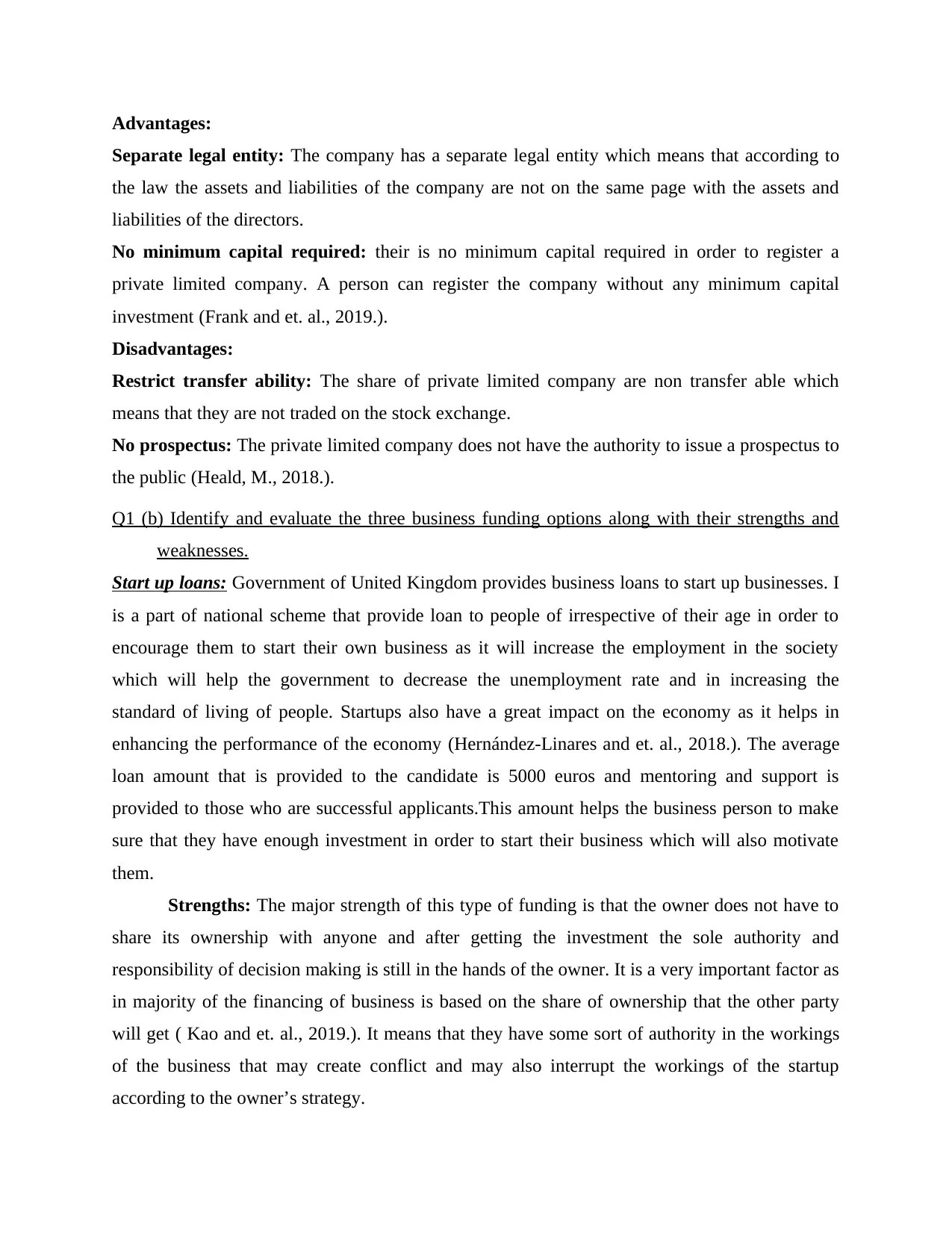
Advantages:
Separate legal entity: The company has a separate legal entity which means that according to
the law the assets and liabilities of the company are not on the same page with the assets and
liabilities of the directors.
No minimum capital required: their is no minimum capital required in order to register a
private limited company. A person can register the company without any minimum capital
investment (Frank and et. al., 2019.).
Disadvantages:
Restrict transfer ability: The share of private limited company are non transfer able which
means that they are not traded on the stock exchange.
No prospectus: The private limited company does not have the authority to issue a prospectus to
the public (Heald, M., 2018.).
Q1 (b) Identify and evaluate the three business funding options along with their strengths and
weaknesses.
Start up loans: Government of United Kingdom provides business loans to start up businesses. I
is a part of national scheme that provide loan to people of irrespective of their age in order to
encourage them to start their own business as it will increase the employment in the society
which will help the government to decrease the unemployment rate and in increasing the
standard of living of people. Startups also have a great impact on the economy as it helps in
enhancing the performance of the economy (Hernández-Linares and et. al., 2018.). The average
loan amount that is provided to the candidate is 5000 euros and mentoring and support is
provided to those who are successful applicants.This amount helps the business person to make
sure that they have enough investment in order to start their business which will also motivate
them.
Strengths: The major strength of this type of funding is that the owner does not have to
share its ownership with anyone and after getting the investment the sole authority and
responsibility of decision making is still in the hands of the owner. It is a very important factor as
in majority of the financing of business is based on the share of ownership that the other party
will get ( Kao and et. al., 2019.). It means that they have some sort of authority in the workings
of the business that may create conflict and may also interrupt the workings of the startup
according to the owner’s strategy.
Separate legal entity: The company has a separate legal entity which means that according to
the law the assets and liabilities of the company are not on the same page with the assets and
liabilities of the directors.
No minimum capital required: their is no minimum capital required in order to register a
private limited company. A person can register the company without any minimum capital
investment (Frank and et. al., 2019.).
Disadvantages:
Restrict transfer ability: The share of private limited company are non transfer able which
means that they are not traded on the stock exchange.
No prospectus: The private limited company does not have the authority to issue a prospectus to
the public (Heald, M., 2018.).
Q1 (b) Identify and evaluate the three business funding options along with their strengths and
weaknesses.
Start up loans: Government of United Kingdom provides business loans to start up businesses. I
is a part of national scheme that provide loan to people of irrespective of their age in order to
encourage them to start their own business as it will increase the employment in the society
which will help the government to decrease the unemployment rate and in increasing the
standard of living of people. Startups also have a great impact on the economy as it helps in
enhancing the performance of the economy (Hernández-Linares and et. al., 2018.). The average
loan amount that is provided to the candidate is 5000 euros and mentoring and support is
provided to those who are successful applicants.This amount helps the business person to make
sure that they have enough investment in order to start their business which will also motivate
them.
Strengths: The major strength of this type of funding is that the owner does not have to
share its ownership with anyone and after getting the investment the sole authority and
responsibility of decision making is still in the hands of the owner. It is a very important factor as
in majority of the financing of business is based on the share of ownership that the other party
will get ( Kao and et. al., 2019.). It means that they have some sort of authority in the workings
of the business that may create conflict and may also interrupt the workings of the startup
according to the owner’s strategy.
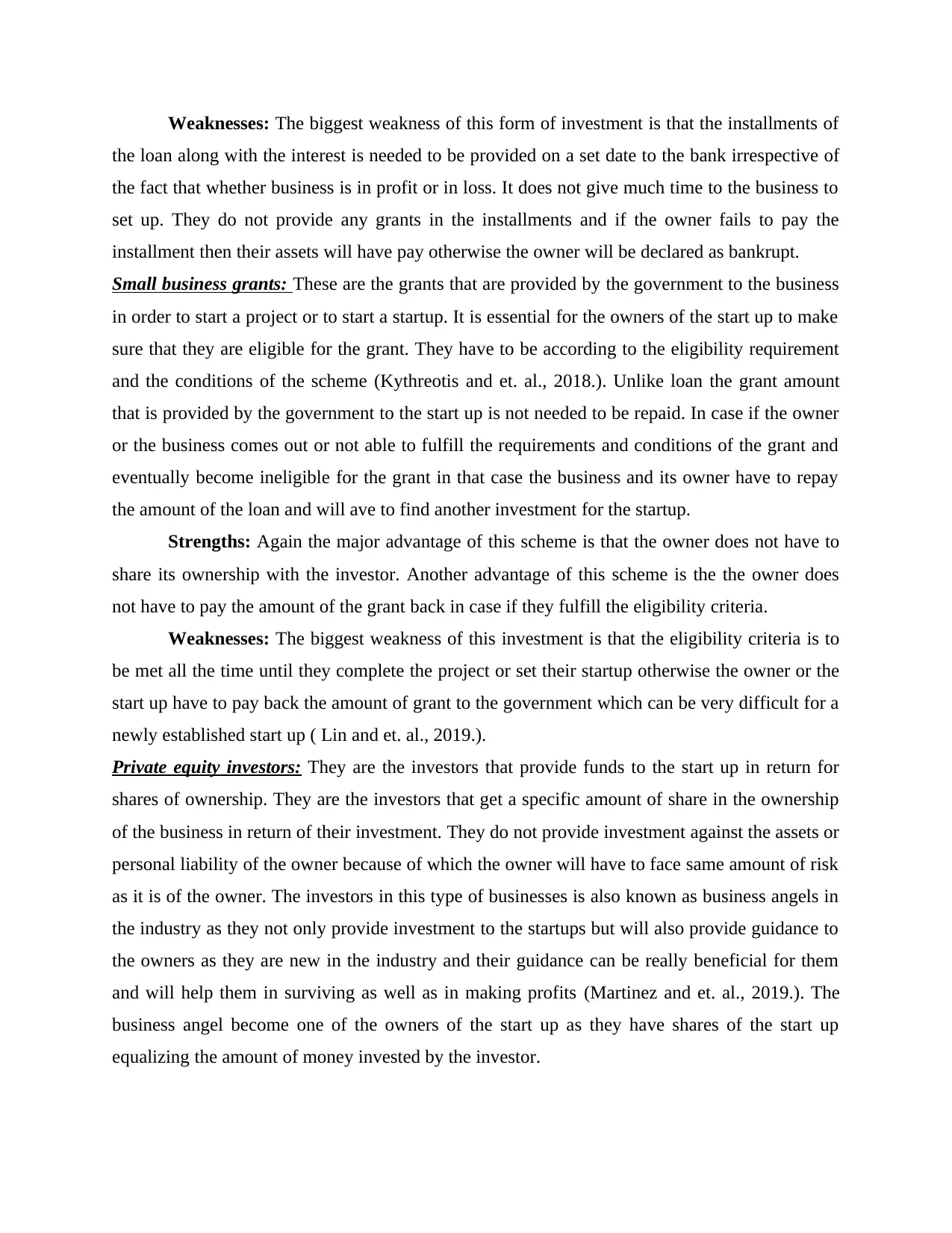
Weaknesses: The biggest weakness of this form of investment is that the installments of
the loan along with the interest is needed to be provided on a set date to the bank irrespective of
the fact that whether business is in profit or in loss. It does not give much time to the business to
set up. They do not provide any grants in the installments and if the owner fails to pay the
installment then their assets will have pay otherwise the owner will be declared as bankrupt.
Small business grants: These are the grants that are provided by the government to the business
in order to start a project or to start a startup. It is essential for the owners of the start up to make
sure that they are eligible for the grant. They have to be according to the eligibility requirement
and the conditions of the scheme (Kythreotis and et. al., 2018.). Unlike loan the grant amount
that is provided by the government to the start up is not needed to be repaid. In case if the owner
or the business comes out or not able to fulfill the requirements and conditions of the grant and
eventually become ineligible for the grant in that case the business and its owner have to repay
the amount of the loan and will ave to find another investment for the startup.
Strengths: Again the major advantage of this scheme is that the owner does not have to
share its ownership with the investor. Another advantage of this scheme is the the owner does
not have to pay the amount of the grant back in case if they fulfill the eligibility criteria.
Weaknesses: The biggest weakness of this investment is that the eligibility criteria is to
be met all the time until they complete the project or set their startup otherwise the owner or the
start up have to pay back the amount of grant to the government which can be very difficult for a
newly established start up ( Lin and et. al., 2019.).
Private equity investors: They are the investors that provide funds to the start up in return for
shares of ownership. They are the investors that get a specific amount of share in the ownership
of the business in return of their investment. They do not provide investment against the assets or
personal liability of the owner because of which the owner will have to face same amount of risk
as it is of the owner. The investors in this type of businesses is also known as business angels in
the industry as they not only provide investment to the startups but will also provide guidance to
the owners as they are new in the industry and their guidance can be really beneficial for them
and will help them in surviving as well as in making profits (Martinez and et. al., 2019.). The
business angel become one of the owners of the start up as they have shares of the start up
equalizing the amount of money invested by the investor.
the loan along with the interest is needed to be provided on a set date to the bank irrespective of
the fact that whether business is in profit or in loss. It does not give much time to the business to
set up. They do not provide any grants in the installments and if the owner fails to pay the
installment then their assets will have pay otherwise the owner will be declared as bankrupt.
Small business grants: These are the grants that are provided by the government to the business
in order to start a project or to start a startup. It is essential for the owners of the start up to make
sure that they are eligible for the grant. They have to be according to the eligibility requirement
and the conditions of the scheme (Kythreotis and et. al., 2018.). Unlike loan the grant amount
that is provided by the government to the start up is not needed to be repaid. In case if the owner
or the business comes out or not able to fulfill the requirements and conditions of the grant and
eventually become ineligible for the grant in that case the business and its owner have to repay
the amount of the loan and will ave to find another investment for the startup.
Strengths: Again the major advantage of this scheme is that the owner does not have to
share its ownership with the investor. Another advantage of this scheme is the the owner does
not have to pay the amount of the grant back in case if they fulfill the eligibility criteria.
Weaknesses: The biggest weakness of this investment is that the eligibility criteria is to
be met all the time until they complete the project or set their startup otherwise the owner or the
start up have to pay back the amount of grant to the government which can be very difficult for a
newly established start up ( Lin and et. al., 2019.).
Private equity investors: They are the investors that provide funds to the start up in return for
shares of ownership. They are the investors that get a specific amount of share in the ownership
of the business in return of their investment. They do not provide investment against the assets or
personal liability of the owner because of which the owner will have to face same amount of risk
as it is of the owner. The investors in this type of businesses is also known as business angels in
the industry as they not only provide investment to the startups but will also provide guidance to
the owners as they are new in the industry and their guidance can be really beneficial for them
and will help them in surviving as well as in making profits (Martinez and et. al., 2019.). The
business angel become one of the owners of the start up as they have shares of the start up
equalizing the amount of money invested by the investor.
⊘ This is a preview!⊘
Do you want full access?
Subscribe today to unlock all pages.

Trusted by 1+ million students worldwide
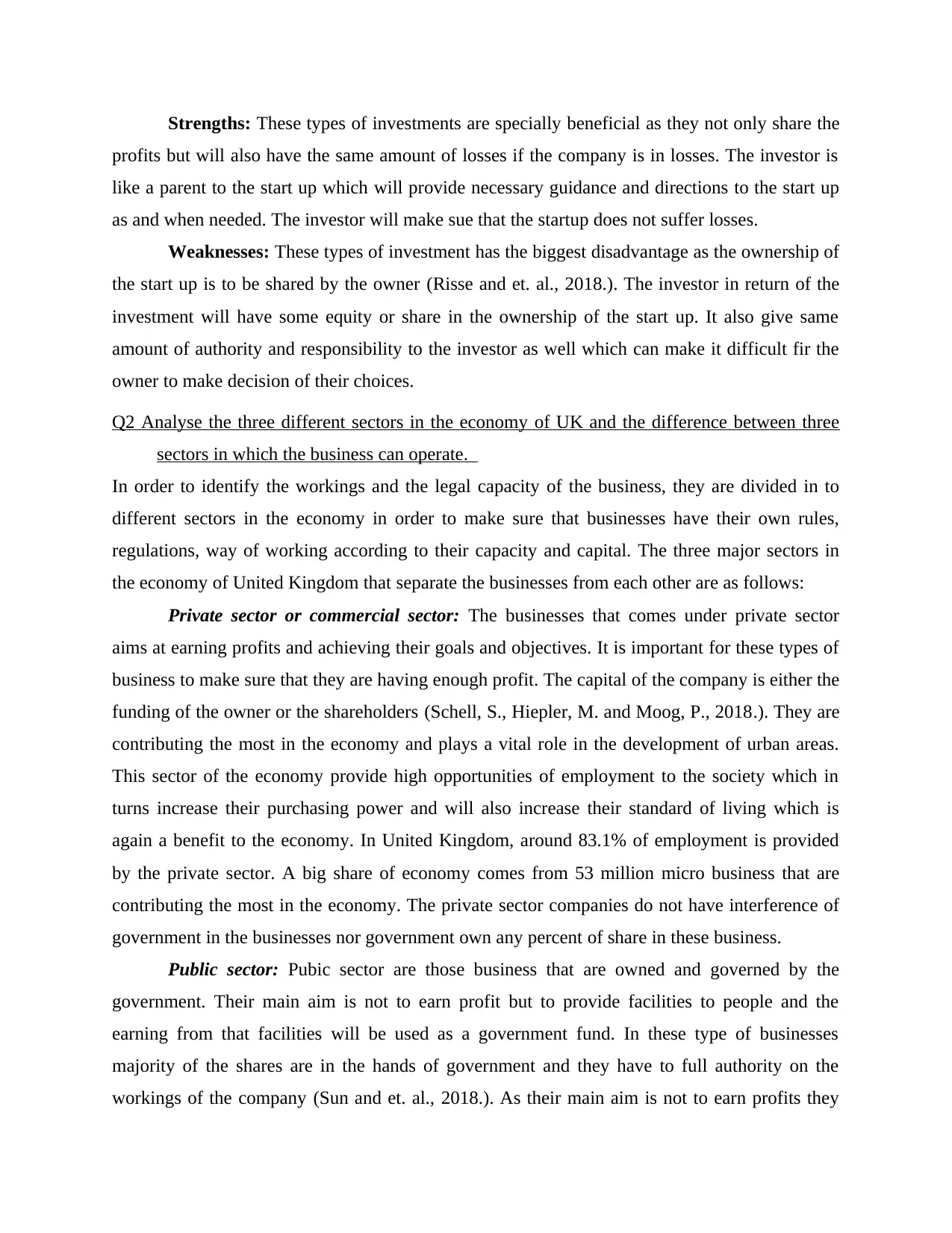
Strengths: These types of investments are specially beneficial as they not only share the
profits but will also have the same amount of losses if the company is in losses. The investor is
like a parent to the start up which will provide necessary guidance and directions to the start up
as and when needed. The investor will make sue that the startup does not suffer losses.
Weaknesses: These types of investment has the biggest disadvantage as the ownership of
the start up is to be shared by the owner (Risse and et. al., 2018.). The investor in return of the
investment will have some equity or share in the ownership of the start up. It also give same
amount of authority and responsibility to the investor as well which can make it difficult fir the
owner to make decision of their choices.
Q2 Analyse the three different sectors in the economy of UK and the difference between three
sectors in which the business can operate.
In order to identify the workings and the legal capacity of the business, they are divided in to
different sectors in the economy in order to make sure that businesses have their own rules,
regulations, way of working according to their capacity and capital. The three major sectors in
the economy of United Kingdom that separate the businesses from each other are as follows:
Private sector or commercial sector: The businesses that comes under private sector
aims at earning profits and achieving their goals and objectives. It is important for these types of
business to make sure that they are having enough profit. The capital of the company is either the
funding of the owner or the shareholders (Schell, S., Hiepler, M. and Moog, P., 2018.). They are
contributing the most in the economy and plays a vital role in the development of urban areas.
This sector of the economy provide high opportunities of employment to the society which in
turns increase their purchasing power and will also increase their standard of living which is
again a benefit to the economy. In United Kingdom, around 83.1% of employment is provided
by the private sector. A big share of economy comes from 53 million micro business that are
contributing the most in the economy. The private sector companies do not have interference of
government in the businesses nor government own any percent of share in these business.
Public sector: Pubic sector are those business that are owned and governed by the
government. Their main aim is not to earn profit but to provide facilities to people and the
earning from that facilities will be used as a government fund. In these type of businesses
majority of the shares are in the hands of government and they have to full authority on the
workings of the company (Sun and et. al., 2018.). As their main aim is not to earn profits they
profits but will also have the same amount of losses if the company is in losses. The investor is
like a parent to the start up which will provide necessary guidance and directions to the start up
as and when needed. The investor will make sue that the startup does not suffer losses.
Weaknesses: These types of investment has the biggest disadvantage as the ownership of
the start up is to be shared by the owner (Risse and et. al., 2018.). The investor in return of the
investment will have some equity or share in the ownership of the start up. It also give same
amount of authority and responsibility to the investor as well which can make it difficult fir the
owner to make decision of their choices.
Q2 Analyse the three different sectors in the economy of UK and the difference between three
sectors in which the business can operate.
In order to identify the workings and the legal capacity of the business, they are divided in to
different sectors in the economy in order to make sure that businesses have their own rules,
regulations, way of working according to their capacity and capital. The three major sectors in
the economy of United Kingdom that separate the businesses from each other are as follows:
Private sector or commercial sector: The businesses that comes under private sector
aims at earning profits and achieving their goals and objectives. It is important for these types of
business to make sure that they are having enough profit. The capital of the company is either the
funding of the owner or the shareholders (Schell, S., Hiepler, M. and Moog, P., 2018.). They are
contributing the most in the economy and plays a vital role in the development of urban areas.
This sector of the economy provide high opportunities of employment to the society which in
turns increase their purchasing power and will also increase their standard of living which is
again a benefit to the economy. In United Kingdom, around 83.1% of employment is provided
by the private sector. A big share of economy comes from 53 million micro business that are
contributing the most in the economy. The private sector companies do not have interference of
government in the businesses nor government own any percent of share in these business.
Public sector: Pubic sector are those business that are owned and governed by the
government. Their main aim is not to earn profit but to provide facilities to people and the
earning from that facilities will be used as a government fund. In these type of businesses
majority of the shares are in the hands of government and they have to full authority on the
workings of the company (Sun and et. al., 2018.). As their main aim is not to earn profits they
Paraphrase This Document
Need a fresh take? Get an instant paraphrase of this document with our AI Paraphraser
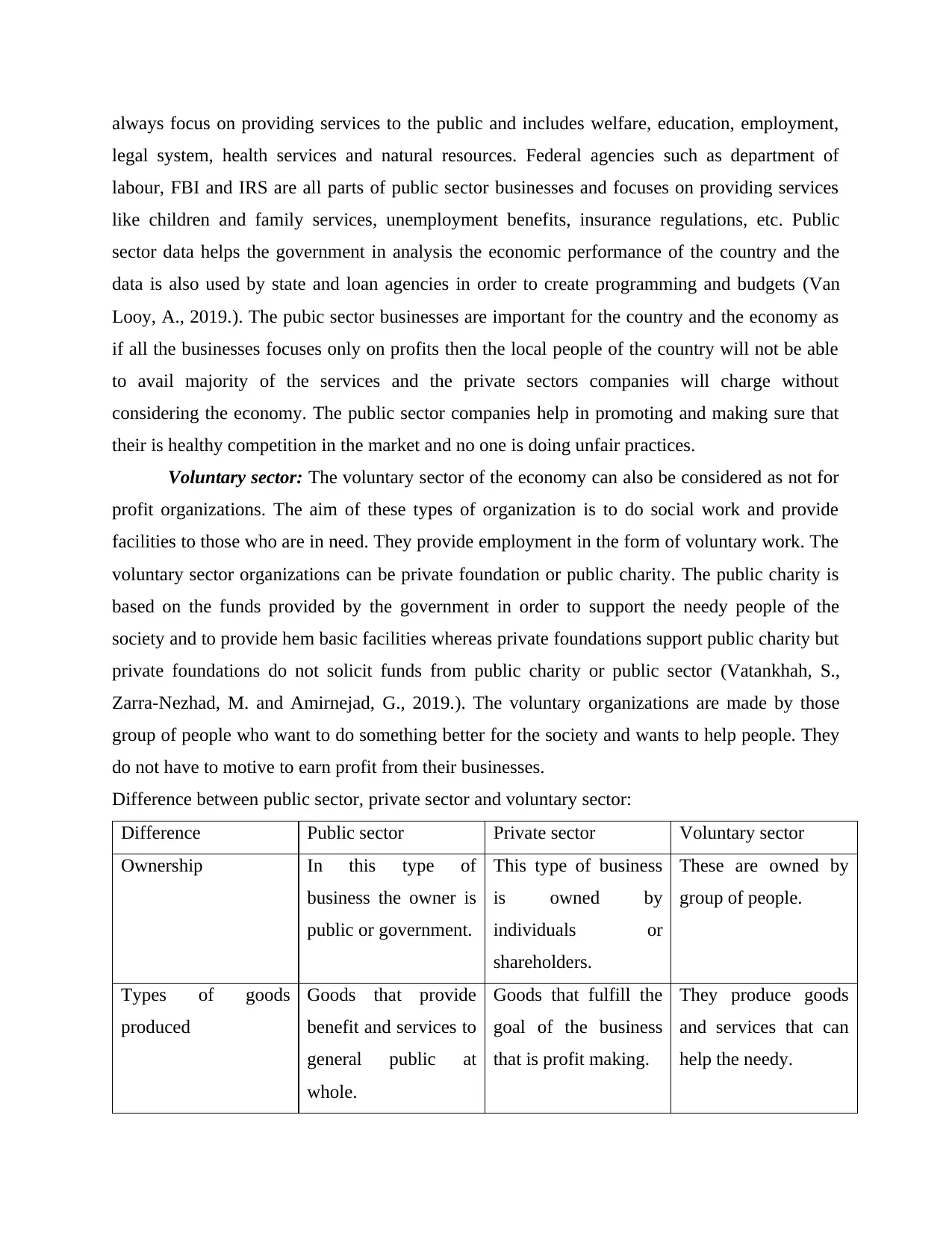
always focus on providing services to the public and includes welfare, education, employment,
legal system, health services and natural resources. Federal agencies such as department of
labour, FBI and IRS are all parts of public sector businesses and focuses on providing services
like children and family services, unemployment benefits, insurance regulations, etc. Public
sector data helps the government in analysis the economic performance of the country and the
data is also used by state and loan agencies in order to create programming and budgets (Van
Looy, A., 2019.). The pubic sector businesses are important for the country and the economy as
if all the businesses focuses only on profits then the local people of the country will not be able
to avail majority of the services and the private sectors companies will charge without
considering the economy. The public sector companies help in promoting and making sure that
their is healthy competition in the market and no one is doing unfair practices.
Voluntary sector: The voluntary sector of the economy can also be considered as not for
profit organizations. The aim of these types of organization is to do social work and provide
facilities to those who are in need. They provide employment in the form of voluntary work. The
voluntary sector organizations can be private foundation or public charity. The public charity is
based on the funds provided by the government in order to support the needy people of the
society and to provide hem basic facilities whereas private foundations support public charity but
private foundations do not solicit funds from public charity or public sector (Vatankhah, S.,
Zarra-Nezhad, M. and Amirnejad, G., 2019.). The voluntary organizations are made by those
group of people who want to do something better for the society and wants to help people. They
do not have to motive to earn profit from their businesses.
Difference between public sector, private sector and voluntary sector:
Difference Public sector Private sector Voluntary sector
Ownership In this type of
business the owner is
public or government.
This type of business
is owned by
individuals or
shareholders.
These are owned by
group of people.
Types of goods
produced
Goods that provide
benefit and services to
general public at
whole.
Goods that fulfill the
goal of the business
that is profit making.
They produce goods
and services that can
help the needy.
legal system, health services and natural resources. Federal agencies such as department of
labour, FBI and IRS are all parts of public sector businesses and focuses on providing services
like children and family services, unemployment benefits, insurance regulations, etc. Public
sector data helps the government in analysis the economic performance of the country and the
data is also used by state and loan agencies in order to create programming and budgets (Van
Looy, A., 2019.). The pubic sector businesses are important for the country and the economy as
if all the businesses focuses only on profits then the local people of the country will not be able
to avail majority of the services and the private sectors companies will charge without
considering the economy. The public sector companies help in promoting and making sure that
their is healthy competition in the market and no one is doing unfair practices.
Voluntary sector: The voluntary sector of the economy can also be considered as not for
profit organizations. The aim of these types of organization is to do social work and provide
facilities to those who are in need. They provide employment in the form of voluntary work. The
voluntary sector organizations can be private foundation or public charity. The public charity is
based on the funds provided by the government in order to support the needy people of the
society and to provide hem basic facilities whereas private foundations support public charity but
private foundations do not solicit funds from public charity or public sector (Vatankhah, S.,
Zarra-Nezhad, M. and Amirnejad, G., 2019.). The voluntary organizations are made by those
group of people who want to do something better for the society and wants to help people. They
do not have to motive to earn profit from their businesses.
Difference between public sector, private sector and voluntary sector:
Difference Public sector Private sector Voluntary sector
Ownership In this type of
business the owner is
public or government.
This type of business
is owned by
individuals or
shareholders.
These are owned by
group of people.
Types of goods
produced
Goods that provide
benefit and services to
general public at
whole.
Goods that fulfill the
goal of the business
that is profit making.
They produce goods
and services that can
help the needy.
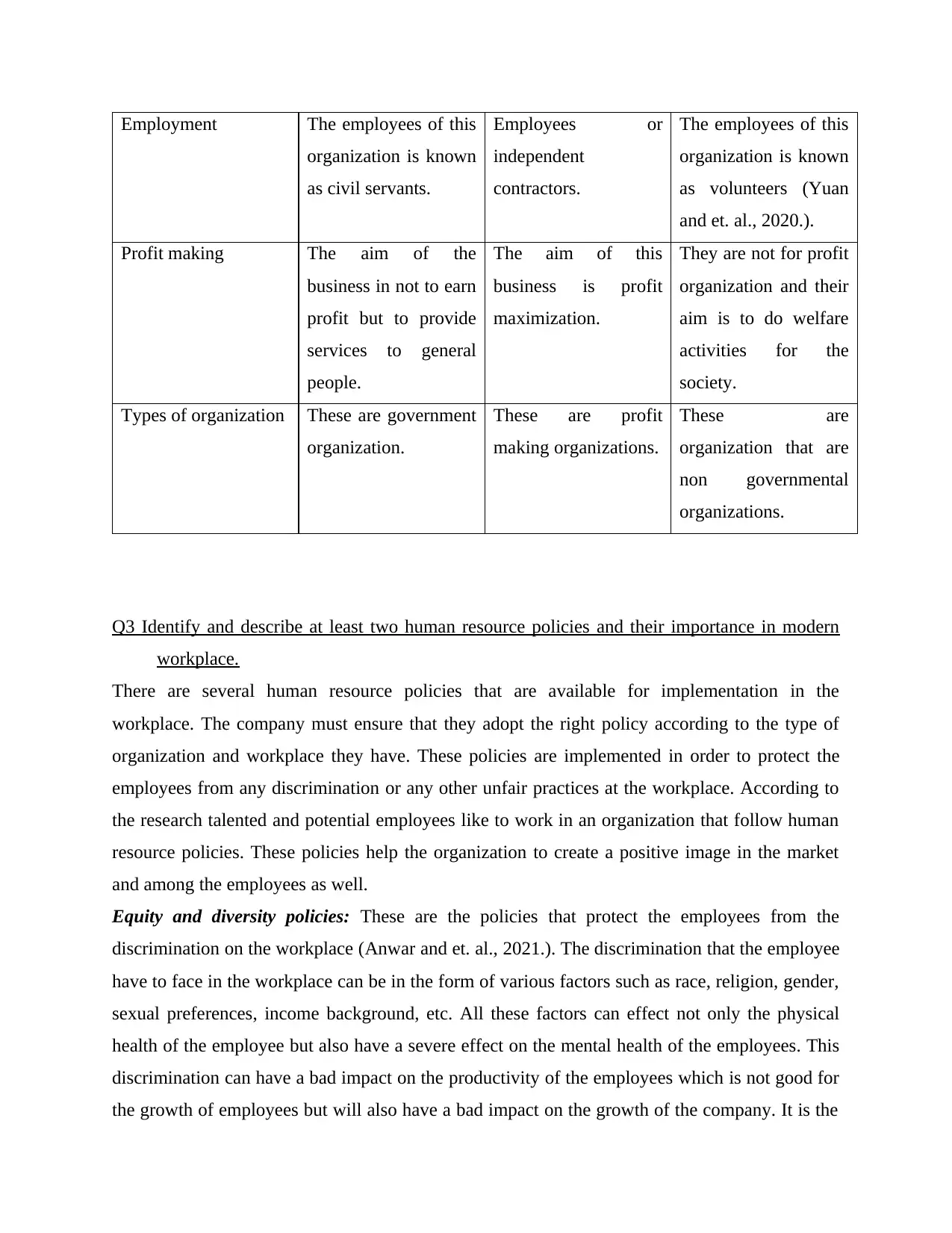
Employment The employees of this
organization is known
as civil servants.
Employees or
independent
contractors.
The employees of this
organization is known
as volunteers (Yuan
and et. al., 2020.).
Profit making The aim of the
business in not to earn
profit but to provide
services to general
people.
The aim of this
business is profit
maximization.
They are not for profit
organization and their
aim is to do welfare
activities for the
society.
Types of organization These are government
organization.
These are profit
making organizations.
These are
organization that are
non governmental
organizations.
Q3 Identify and describe at least two human resource policies and their importance in modern
workplace.
There are several human resource policies that are available for implementation in the
workplace. The company must ensure that they adopt the right policy according to the type of
organization and workplace they have. These policies are implemented in order to protect the
employees from any discrimination or any other unfair practices at the workplace. According to
the research talented and potential employees like to work in an organization that follow human
resource policies. These policies help the organization to create a positive image in the market
and among the employees as well.
Equity and diversity policies: These are the policies that protect the employees from the
discrimination on the workplace (Anwar and et. al., 2021.). The discrimination that the employee
have to face in the workplace can be in the form of various factors such as race, religion, gender,
sexual preferences, income background, etc. All these factors can effect not only the physical
health of the employee but also have a severe effect on the mental health of the employees. This
discrimination can have a bad impact on the productivity of the employees which is not good for
the growth of employees but will also have a bad impact on the growth of the company. It is the
organization is known
as civil servants.
Employees or
independent
contractors.
The employees of this
organization is known
as volunteers (Yuan
and et. al., 2020.).
Profit making The aim of the
business in not to earn
profit but to provide
services to general
people.
The aim of this
business is profit
maximization.
They are not for profit
organization and their
aim is to do welfare
activities for the
society.
Types of organization These are government
organization.
These are profit
making organizations.
These are
organization that are
non governmental
organizations.
Q3 Identify and describe at least two human resource policies and their importance in modern
workplace.
There are several human resource policies that are available for implementation in the
workplace. The company must ensure that they adopt the right policy according to the type of
organization and workplace they have. These policies are implemented in order to protect the
employees from any discrimination or any other unfair practices at the workplace. According to
the research talented and potential employees like to work in an organization that follow human
resource policies. These policies help the organization to create a positive image in the market
and among the employees as well.
Equity and diversity policies: These are the policies that protect the employees from the
discrimination on the workplace (Anwar and et. al., 2021.). The discrimination that the employee
have to face in the workplace can be in the form of various factors such as race, religion, gender,
sexual preferences, income background, etc. All these factors can effect not only the physical
health of the employee but also have a severe effect on the mental health of the employees. This
discrimination can have a bad impact on the productivity of the employees which is not good for
the growth of employees but will also have a bad impact on the growth of the company. It is the
⊘ This is a preview!⊘
Do you want full access?
Subscribe today to unlock all pages.

Trusted by 1+ million students worldwide
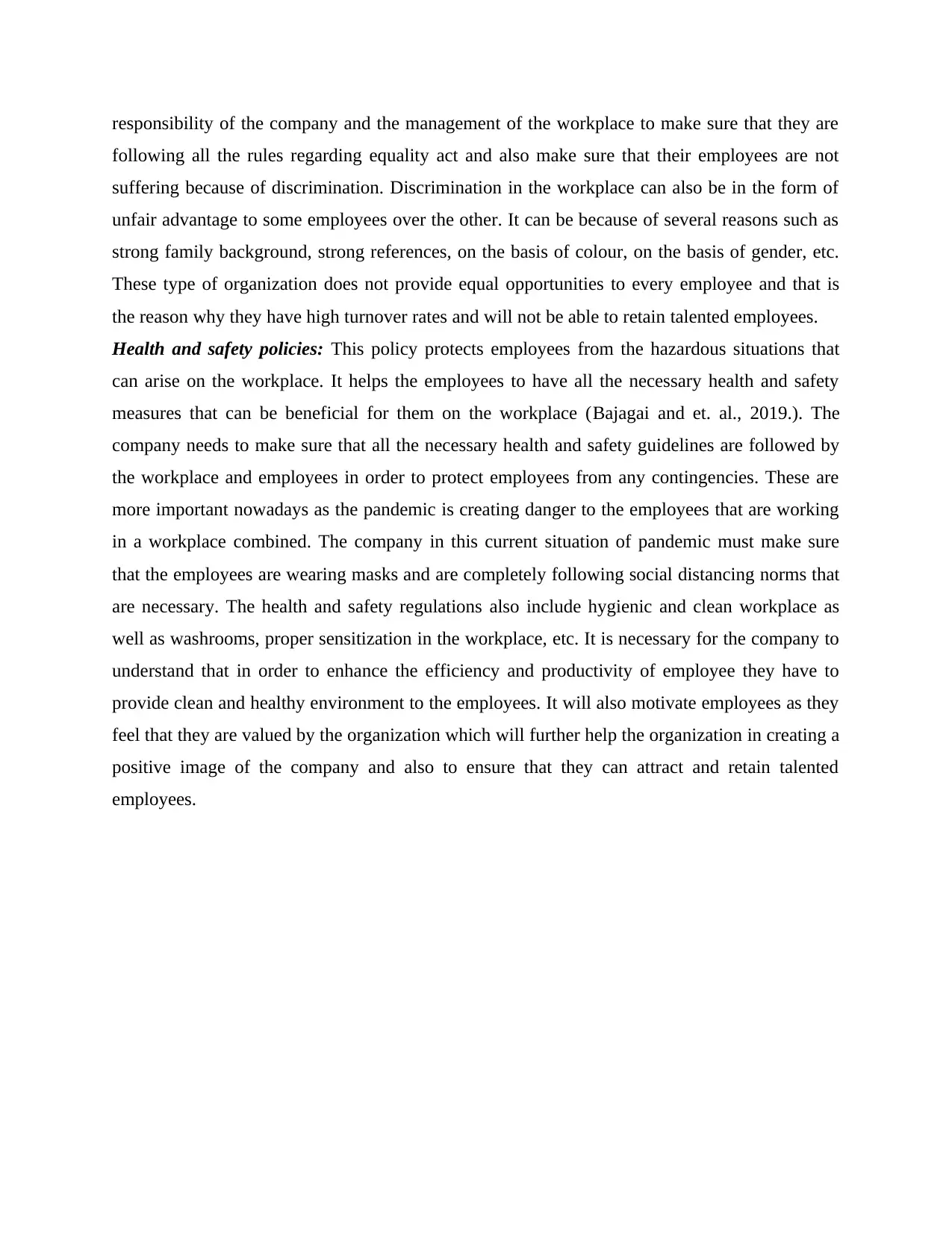
responsibility of the company and the management of the workplace to make sure that they are
following all the rules regarding equality act and also make sure that their employees are not
suffering because of discrimination. Discrimination in the workplace can also be in the form of
unfair advantage to some employees over the other. It can be because of several reasons such as
strong family background, strong references, on the basis of colour, on the basis of gender, etc.
These type of organization does not provide equal opportunities to every employee and that is
the reason why they have high turnover rates and will not be able to retain talented employees.
Health and safety policies: This policy protects employees from the hazardous situations that
can arise on the workplace. It helps the employees to have all the necessary health and safety
measures that can be beneficial for them on the workplace (Bajagai and et. al., 2019.). The
company needs to make sure that all the necessary health and safety guidelines are followed by
the workplace and employees in order to protect employees from any contingencies. These are
more important nowadays as the pandemic is creating danger to the employees that are working
in a workplace combined. The company in this current situation of pandemic must make sure
that the employees are wearing masks and are completely following social distancing norms that
are necessary. The health and safety regulations also include hygienic and clean workplace as
well as washrooms, proper sensitization in the workplace, etc. It is necessary for the company to
understand that in order to enhance the efficiency and productivity of employee they have to
provide clean and healthy environment to the employees. It will also motivate employees as they
feel that they are valued by the organization which will further help the organization in creating a
positive image of the company and also to ensure that they can attract and retain talented
employees.
following all the rules regarding equality act and also make sure that their employees are not
suffering because of discrimination. Discrimination in the workplace can also be in the form of
unfair advantage to some employees over the other. It can be because of several reasons such as
strong family background, strong references, on the basis of colour, on the basis of gender, etc.
These type of organization does not provide equal opportunities to every employee and that is
the reason why they have high turnover rates and will not be able to retain talented employees.
Health and safety policies: This policy protects employees from the hazardous situations that
can arise on the workplace. It helps the employees to have all the necessary health and safety
measures that can be beneficial for them on the workplace (Bajagai and et. al., 2019.). The
company needs to make sure that all the necessary health and safety guidelines are followed by
the workplace and employees in order to protect employees from any contingencies. These are
more important nowadays as the pandemic is creating danger to the employees that are working
in a workplace combined. The company in this current situation of pandemic must make sure
that the employees are wearing masks and are completely following social distancing norms that
are necessary. The health and safety regulations also include hygienic and clean workplace as
well as washrooms, proper sensitization in the workplace, etc. It is necessary for the company to
understand that in order to enhance the efficiency and productivity of employee they have to
provide clean and healthy environment to the employees. It will also motivate employees as they
feel that they are valued by the organization which will further help the organization in creating a
positive image of the company and also to ensure that they can attract and retain talented
employees.
Paraphrase This Document
Need a fresh take? Get an instant paraphrase of this document with our AI Paraphraser

CONCLUSION
It is concluded from the above report that if a start up has to become successful then they must
find the right funding solution that are suitable for their start up. It required lot of patience and
hard work to convert an idea into reality and by selecting the right option of human resource
policies and legal status of the company, the start up can become successful.
It is concluded from the above report that if a start up has to become successful then they must
find the right funding solution that are suitable for their start up. It required lot of patience and
hard work to convert an idea into reality and by selecting the right option of human resource
policies and legal status of the company, the start up can become successful.
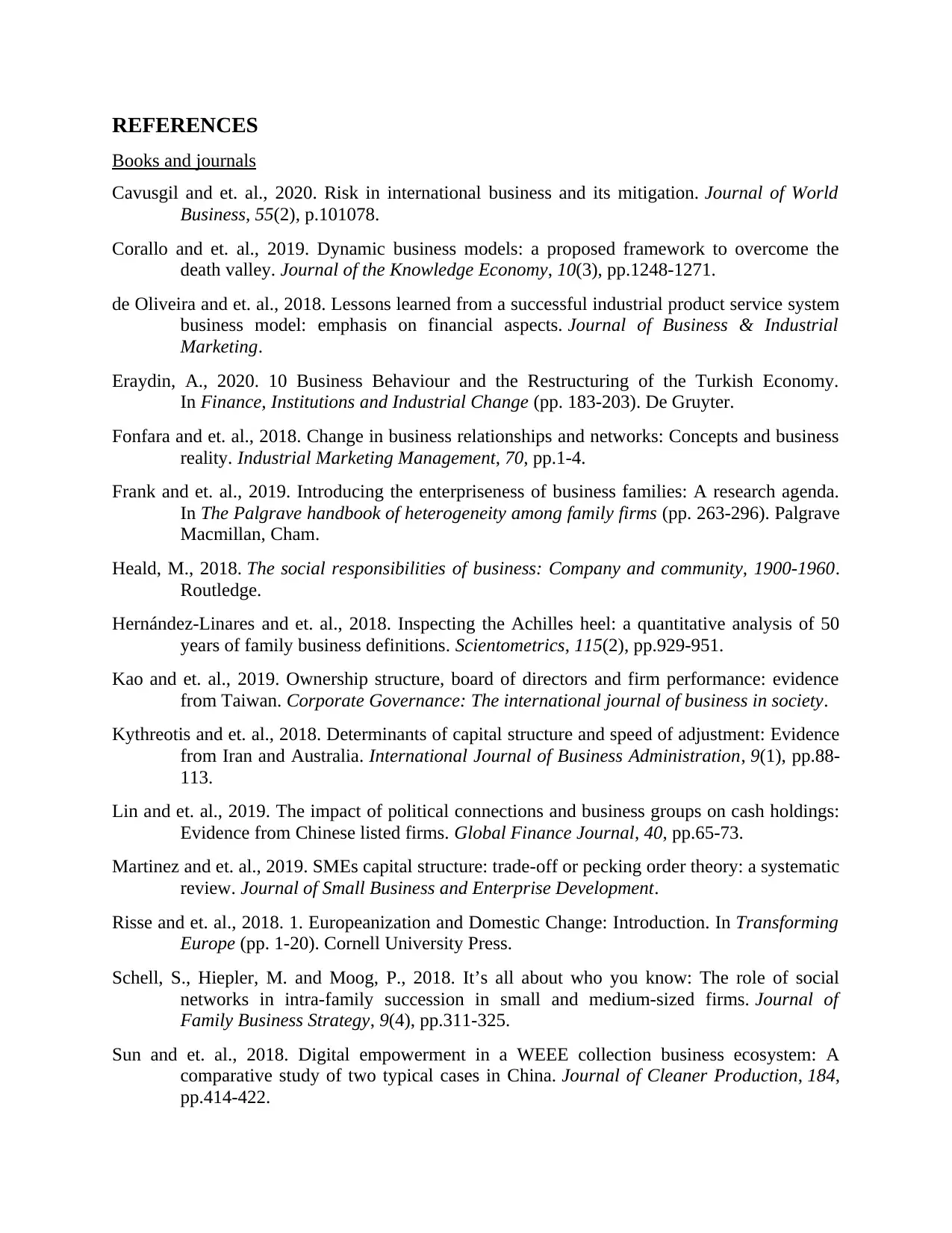
REFERENCES
Books and journals
Cavusgil and et. al., 2020. Risk in international business and its mitigation. Journal of World
Business, 55(2), p.101078.
Corallo and et. al., 2019. Dynamic business models: a proposed framework to overcome the
death valley. Journal of the Knowledge Economy, 10(3), pp.1248-1271.
de Oliveira and et. al., 2018. Lessons learned from a successful industrial product service system
business model: emphasis on financial aspects. Journal of Business & Industrial
Marketing.
Eraydin, A., 2020. 10 Business Behaviour and the Restructuring of the Turkish Economy.
In Finance, Institutions and Industrial Change (pp. 183-203). De Gruyter.
Fonfara and et. al., 2018. Change in business relationships and networks: Concepts and business
reality. Industrial Marketing Management, 70, pp.1-4.
Frank and et. al., 2019. Introducing the enterpriseness of business families: A research agenda.
In The Palgrave handbook of heterogeneity among family firms (pp. 263-296). Palgrave
Macmillan, Cham.
Heald, M., 2018. The social responsibilities of business: Company and community, 1900-1960.
Routledge.
Hernández-Linares and et. al., 2018. Inspecting the Achilles heel: a quantitative analysis of 50
years of family business definitions. Scientometrics, 115(2), pp.929-951.
Kao and et. al., 2019. Ownership structure, board of directors and firm performance: evidence
from Taiwan. Corporate Governance: The international journal of business in society.
Kythreotis and et. al., 2018. Determinants of capital structure and speed of adjustment: Evidence
from Iran and Australia. International Journal of Business Administration, 9(1), pp.88-
113.
Lin and et. al., 2019. The impact of political connections and business groups on cash holdings:
Evidence from Chinese listed firms. Global Finance Journal, 40, pp.65-73.
Martinez and et. al., 2019. SMEs capital structure: trade-off or pecking order theory: a systematic
review. Journal of Small Business and Enterprise Development.
Risse and et. al., 2018. 1. Europeanization and Domestic Change: Introduction. In Transforming
Europe (pp. 1-20). Cornell University Press.
Schell, S., Hiepler, M. and Moog, P., 2018. It’s all about who you know: The role of social
networks in intra-family succession in small and medium-sized firms. Journal of
Family Business Strategy, 9(4), pp.311-325.
Sun and et. al., 2018. Digital empowerment in a WEEE collection business ecosystem: A
comparative study of two typical cases in China. Journal of Cleaner Production, 184,
pp.414-422.
Books and journals
Cavusgil and et. al., 2020. Risk in international business and its mitigation. Journal of World
Business, 55(2), p.101078.
Corallo and et. al., 2019. Dynamic business models: a proposed framework to overcome the
death valley. Journal of the Knowledge Economy, 10(3), pp.1248-1271.
de Oliveira and et. al., 2018. Lessons learned from a successful industrial product service system
business model: emphasis on financial aspects. Journal of Business & Industrial
Marketing.
Eraydin, A., 2020. 10 Business Behaviour and the Restructuring of the Turkish Economy.
In Finance, Institutions and Industrial Change (pp. 183-203). De Gruyter.
Fonfara and et. al., 2018. Change in business relationships and networks: Concepts and business
reality. Industrial Marketing Management, 70, pp.1-4.
Frank and et. al., 2019. Introducing the enterpriseness of business families: A research agenda.
In The Palgrave handbook of heterogeneity among family firms (pp. 263-296). Palgrave
Macmillan, Cham.
Heald, M., 2018. The social responsibilities of business: Company and community, 1900-1960.
Routledge.
Hernández-Linares and et. al., 2018. Inspecting the Achilles heel: a quantitative analysis of 50
years of family business definitions. Scientometrics, 115(2), pp.929-951.
Kao and et. al., 2019. Ownership structure, board of directors and firm performance: evidence
from Taiwan. Corporate Governance: The international journal of business in society.
Kythreotis and et. al., 2018. Determinants of capital structure and speed of adjustment: Evidence
from Iran and Australia. International Journal of Business Administration, 9(1), pp.88-
113.
Lin and et. al., 2019. The impact of political connections and business groups on cash holdings:
Evidence from Chinese listed firms. Global Finance Journal, 40, pp.65-73.
Martinez and et. al., 2019. SMEs capital structure: trade-off or pecking order theory: a systematic
review. Journal of Small Business and Enterprise Development.
Risse and et. al., 2018. 1. Europeanization and Domestic Change: Introduction. In Transforming
Europe (pp. 1-20). Cornell University Press.
Schell, S., Hiepler, M. and Moog, P., 2018. It’s all about who you know: The role of social
networks in intra-family succession in small and medium-sized firms. Journal of
Family Business Strategy, 9(4), pp.311-325.
Sun and et. al., 2018. Digital empowerment in a WEEE collection business ecosystem: A
comparative study of two typical cases in China. Journal of Cleaner Production, 184,
pp.414-422.
⊘ This is a preview!⊘
Do you want full access?
Subscribe today to unlock all pages.

Trusted by 1+ million students worldwide
1 out of 13
Related Documents
Your All-in-One AI-Powered Toolkit for Academic Success.
+13062052269
info@desklib.com
Available 24*7 on WhatsApp / Email
![[object Object]](/_next/static/media/star-bottom.7253800d.svg)
Unlock your academic potential
Copyright © 2020–2025 A2Z Services. All Rights Reserved. Developed and managed by ZUCOL.





